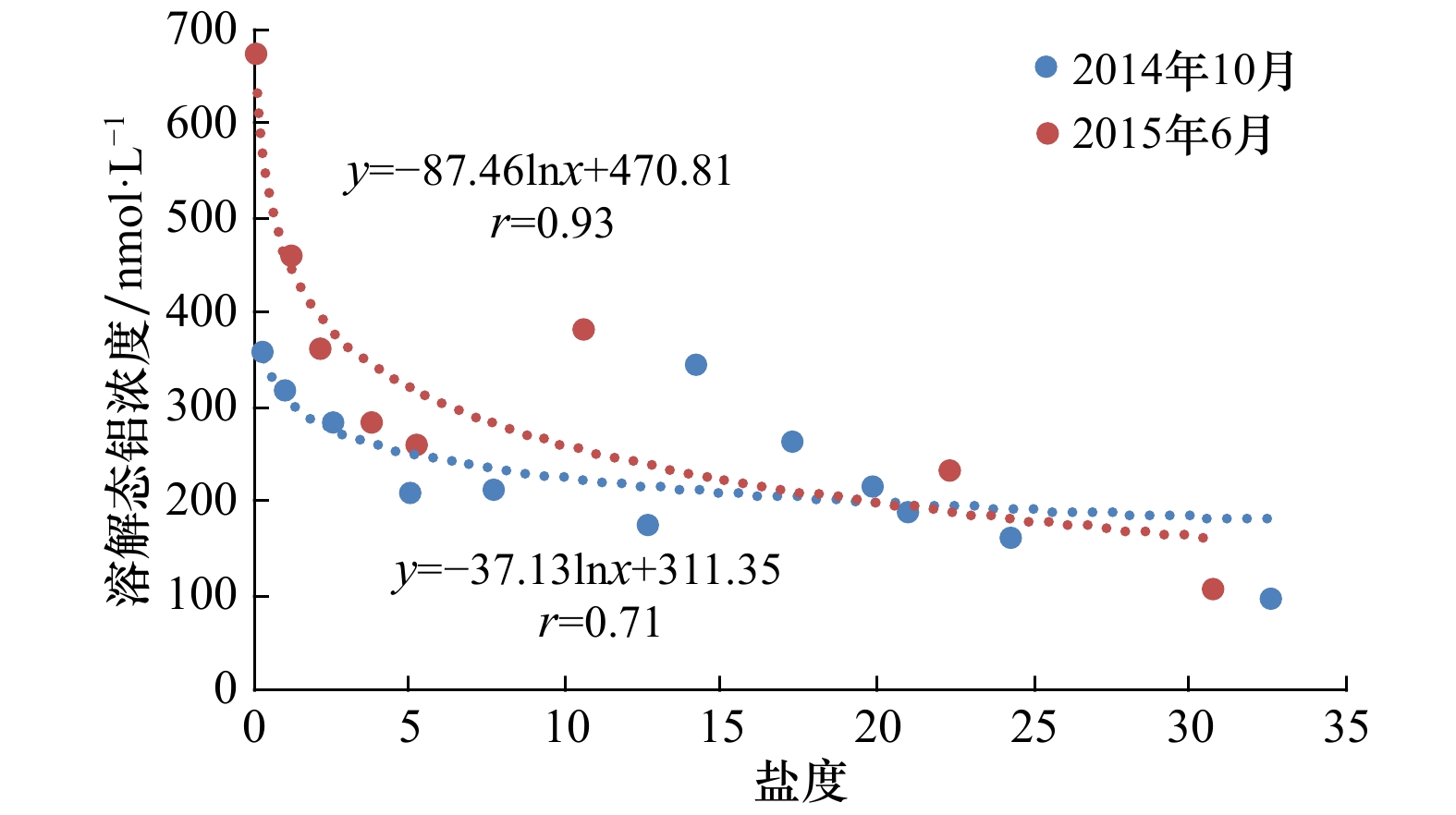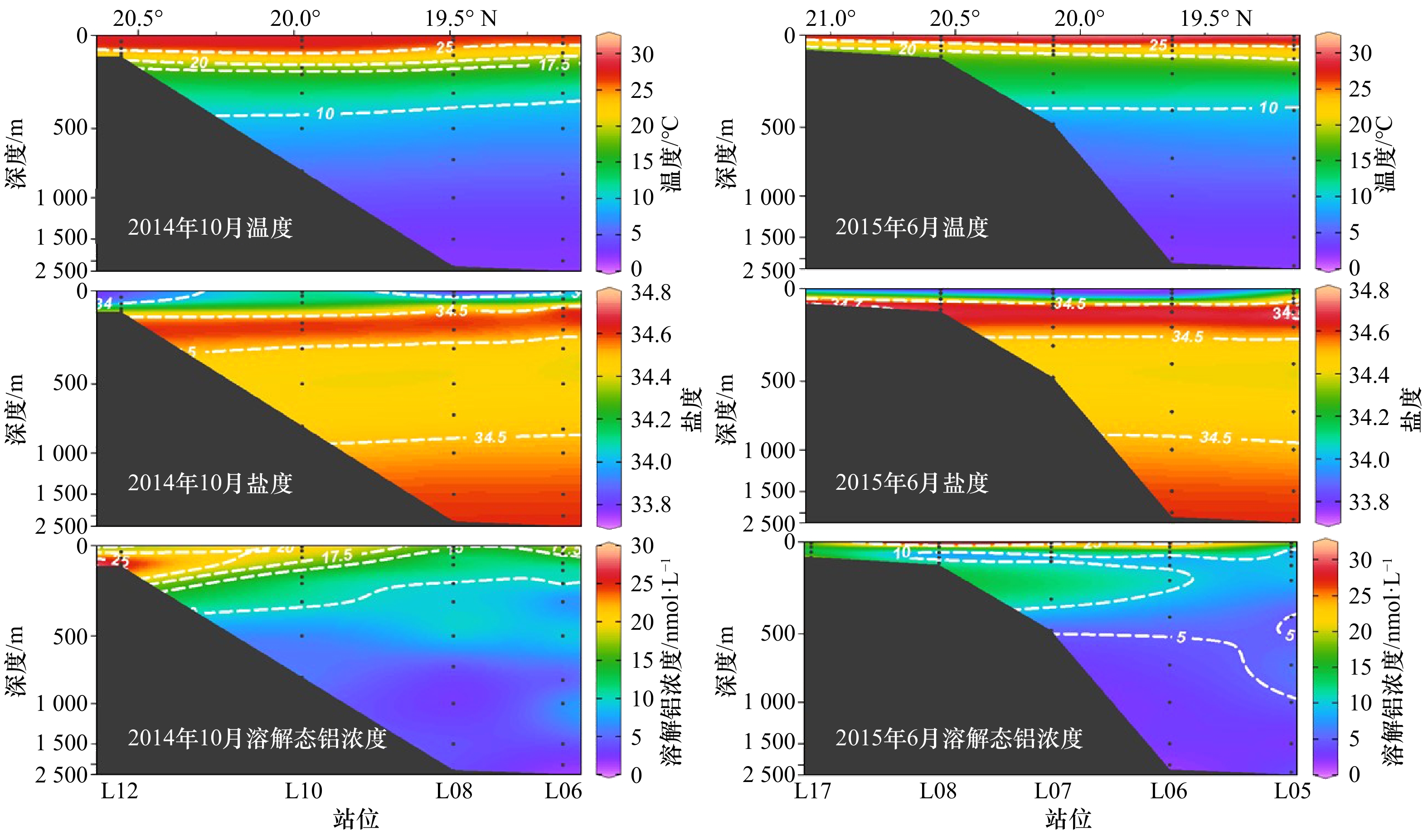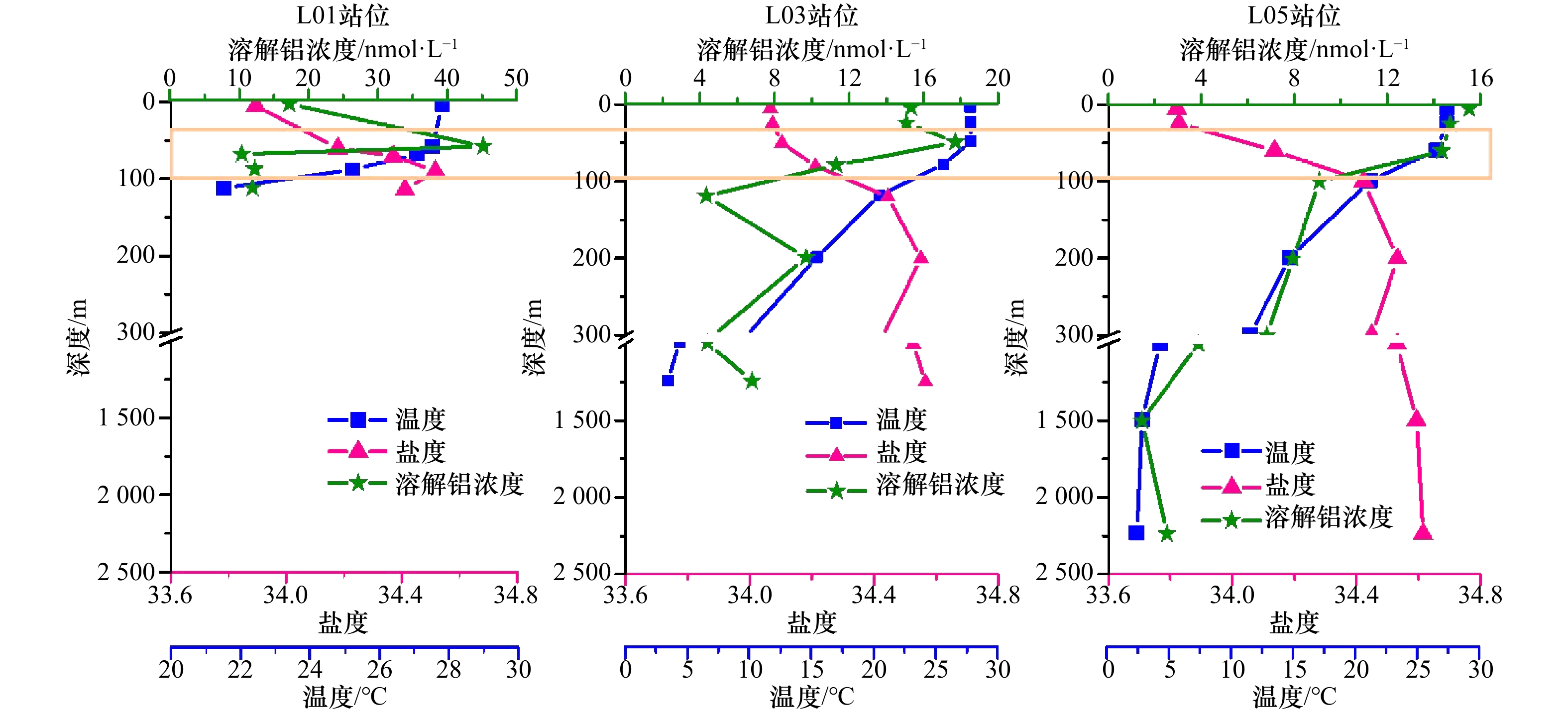Distributions and influencing factors of dissolved aluminum in the Zhujiang River Estuary,continental slope of the northern South China Sea in autumn and summer
-
摘要: 于2014年10月和2015年6月对珠江口、南海北部陆坡区域溶解态铝的分布进行观测,探讨影响其分布及季节差异的主要因素,并以其作为示踪因子探讨潜在的陆源物质跨陆架输送途径。研究结果显示,夏、秋季珠江口盐度为0时溶解态铝的浓度分别为690.0 nmol/L和360.0 nmol/L,在淡咸水混合初期溶解态铝迅速自水体清除,夏季的清除率(55.8%)大于秋季(29.7%)。在南海北部陆坡区域,夏季表层溶解态铝浓度表现为沿纬线方向西高东低的分布特点,秋季则相反;夏、秋季底层溶解态铝浓度均呈现出随着离岸距离增加逐渐降低的分布趋势。秋季溶解态铝浓度的分布与盐度呈现显著的负相关关系,表明其行为近乎保守,陆架混合水及黑潮次表层水等水团混合是影响南海北部陆坡区域溶解态铝分布的主要因素。并且以溶解态铝作为示踪因子发现,在21.6~22.2 kg/m3密度面区间存在自陆架向陆坡方向的跨陆架输送。而夏季陆坡中部受到珠江冲淡水的影响出现低盐水舌,但溶解态铝的浓度相对较低,表现出明显的不保守行为。浮游植物的清除作用是导致夏季陆坡区域溶解态铝分布异常的重要因素。Abstract: Distributions of dissolved aluminum in the Zhujiang River Estuary and slope of the northern South China Sea (NSCS) were observed in October 2014 and June 2015, respectively. We discuss the main factors affecting its distribution and seasonal variation, and use dissolved aluminum as a tracer to explore the potential cross-shelf transport of terrestrial materials. The concentrations of dissolved aluminum in the Zhujiang River were 690 nmol/L and 360 nmol/L in summer and autumn, respectively. Dissolved aluminum were significantly removed from the water column in the initial mixing of fresh and saline water in the Zhujiang River Estuary, with scavenging rate of 55.8% and 29.7% in summer and autumn, respectively. In the slope of the NSCS, the concentration of dissolved aluminum in the surface decreased from east to west along the latitude in summer and was completely opposite in autumn. The concentrations of dissolved aluminum in the bottom were gradually decreased across the NSCS shelf with the increasing distance from the coast both in summer and autumn. The negative correlation between dissolved aluminum and salinity in autumn indicated that the behavior of dissolved aluminum was nearly conservative and the mixing of different water masses including shelf mixed water and kuroshio subsurface water was the main influencing factor. Dissolved aluminum showed decreasing trend from the continental shelf to the middle of NSCS along the isopycnal surfaces of 21.6 to 22.2 kg/m3, indicating the potential cross-shelf transport path in the NSCS. In summer, there was a water tough with lower salinity appeared in the middle of the study area, indicating the influence of the Zhujiang diluted water. However, the concentration of dissolved aluminum was relatively low corresponding to the water mass with low salinity. Scavenging by phytoplankton bloom in the top mixed layer was the major influencing factor of semi-conservative behavior of dissolved aluminum in summer.
-
图 1 2014年10月和2015年6月南海北部陆坡以及珠江口的采样站位
a、b 代表CTD-Niskin采水器采样站位,c 代表飞鱼采水器采样站位
Fig. 1 The sampling stations of the continental slope of the northern South China Sea and the Zhujiang River Estuary in October 2014 and June 2015
a、b represents the sampling stations collected by CTD-Niskin, c represents the sampling stations collected by Towed-fish
图 2 2014年10月和2015年6月珠江口区域溶解态铝浓度和盐度的关系图
蓝色和红色虚线分别代表2014年10月、2015年6月溶解态铝浓度和盐度的对数拟合线
Fig. 2 The relationship between the dissolved aluminum concentration and salinity in the Zhujiang River Estuary in October 2014 and June 2015
The dotted blue and red lines represent the logarithmic fitting lines of dissolved aluminum concentration and salinity in October 2014 and June 2015, respectively
图 5 秋、夏季溶解态铝-盐度的关系
黑点代表研究区域的值,玫红点代表黑潮次表层水(盐度为35.04,溶解态铝的浓度为6.2 nmol/L)和陆架混合水的端元值(盐度为31.00,溶解态铝的浓度为66.4 nmol/L)
Fig. 5 The relationship between dissolved aluminum concentration and salinity in autumn and summer respectively
The black dots represent the value of the study area; the red rose dots represent the end element value of the Kuroshio Subsurface Water (salinity: 35.04, dissolved aluminum concentrion: 6.2 nmol/L) and the mixed water of continental shelf (salinity: 31.00, dissolved aluminum concentrion: 66.4 nmol/L)
图 6 2015年6月叶绿素a浓度的卫星遥感图片(https://worldview.earthdata.nasa.gov/) (a)及夏季混合层溶解态铝的清除比例(叶绿素a的浓度为不等间距坐标) (b)
Fig. 6 Chlorophyll a satellite remote sensing images in June 2015(https://worldview.earthdata.nasa.gov/) (a) and removed proportion of the dissolved aluminum in mixed layer in the summer (note that the use of different scales for chlorophyll a) (b)
表 1 GEOTRACES互校样品测定结果
Tab. 1 The results of GEOTRACES cross-calibrated sample
标准样品 推荐值/ nmol·L−1 实测值/ nmol·L−1 GS (GEOTRACES 大西洋地表水样本) 27.2±0.3 27.2±0.3 GD (GEOTRACES 大西洋深水样本) 18.0±0.7 17.7±0.2 表 2 2014年10月和2015年6月南海北部陆坡表、底层温度、盐度、溶解态铝的浓度范围及平均值
Tab. 2 Concentration ranges and the averages of temperature, salinity and dissolved aluminum concentration in the northern continental slope of the South China Sea in October 2014 and June 2015
季节 采水器 区域 层次 温度/ ℃ 盐度 溶解态铝浓度/ nmol·L−1 秋季 飞鱼 珠江口 表层 − 0.20~33.90 20.0~360.0 陆坡 表层 25.2~28.4 33.31~34.10 8.9~24.7 (27.7±0.5) (33.78±0.20) (18.1±7.2) CTD-Niskin 陆坡 表层 26.8~27.9 33.50~34.12 13.9~27.0 (27.5±0.3) (33.89±0.18) (18.1±3.6) 底层 2.4~22.2 34.33~34.57 2.2~25.4 (9.8±8.6) (34.52±0.09) (7.7±6.9) 夏季 飞鱼 珠江口 表层 − 0.11~33.80 18.6~674.4 陆坡 表层 − − 7.9~17.9 (12.6±3.0) CTD-Niskin 陆坡 表层 29.3~31.1 31.43~34.04 9.7~32.0 (30.6±0.6) (33.44±0.93) (19.9±6.5) 底层 2.4~18.3 34.41~34.63 2.0~19.8 (9.2±5.9) (34.57±0.08) (8.2±5.5) 注:“−”代表未测数据;括号里的数据代表平均值
(夏季飞鱼和CTD-Niskin采水器采集表层样品的区域不完全一致,取相同区域铝的数据进行Mann-Whitney U检验,p >0.05, n=27, 无显著性差异)。 -
[1] Taylor S R. Abundance of chemical elements in the continental crust: a new table[J]. Geochimica et Cosmochimica Acta, 1964, 28(8): 1273−1285. doi: 10.1016/0016-7037(64)90129-2 [2] Measures C, Hatta M, Fitzsimmons J, et al. Dissolved Al in the zonal N Atlantic section of the US GEOTRACES 2010/2011 cruises and the importance of hydrothermal inputs[J]. Deep Sea Research Part II: Topical Studies in Oceanography, 2015, 116: 176−186. doi: 10.1016/j.dsr2.2014.07.006 [3] Middag R, Van Hulten M M P, Van Aken H M, et al. Dissolved aluminium in the ocean conveyor of the West Atlantic Ocean: effects of the biological cycle, scavenging, sediment resuspension and hydrography[J]. Marine Chemistry, 2015, 177: 69−86. doi: 10.1016/j.marchem.2015.02.015 [4] Kaupp L J, Measures C I, Selph K E, et al. The distribution of dissolved Fe and Al in the upper waters of the Eastern Equatorial Pacific[J]. Deep Sea Research Part II: Topical Studies in Oceanography, 2011, 58(3/4): 296−310. [5] Middag R, Van Slooten C, De Baar H J W, et al. Dissolved aluminium in the southern Ocean[J]. Deep Sea Research Part Ⅱ: Topical Studies in Oceanography, 2011, 58(25/26): 2647−2660. [6] Shelley R U, Roca-Martí M, Castrillejo M, et al. Quantification of trace element atmospheric deposition fluxes to the Atlantic Ocean (>40°N; GEOVIDE, GEOTRACES GA01) during spring 2014[J]. Deep Sea Research Part Ⅰ: Oceanographic Research Papers, 2017, 119: 34−49. doi: 10.1016/j.dsr.2016.11.010 [7] Grand M M, Measures C I, Hatta M, et al. The impact of circulation and dust deposition in controlling the distributions of dissolved Fe and Al in the south Indian subtropical gyre[J]. Marine Chemistry, 2015, 176: 110−125. doi: 10.1016/j.marchem.2015.08.002 [8] Lam P J, Bishop J K B, Henning C C, et al. Wintertime Phytoplankton bloom in the subarctic Pacific supported by continental margin iron[J]. Global Biogeochemical Cycles, 2006, 20(1): GB1006. [9] Cullen J T, Chong M, Ianson D. British Columbian continental shelf as a source of dissolved iron to the subarctic northeast Pacific Ocean[J]. Global Biogeochemical Cycles, 2009, 23(4): GB4012. [10] Ren Jingling, Xuan Jiliang, Wang Zhaowei, et al. Cross-shelf transport of terrestrial Al enhanced by the transition of northeasterly to southwesterly monsoon wind over the East China Sea[J]. Journal of Geophysical Research: Oceans, 2015, 120(7): 5054−5073. doi: 10.1002/2014JC010655 [11] Li Lei, Li Faming, Wang Zhaowei, et al. Factors influencing the use of dissolved aluminum as a source tracer in the East China Sea and adjacent waters[J]. Marine Chemistry, 2018, 204: 133−143. doi: 10.1016/j.marchem.2018.05.009 [12] Measures C I, Vink S. On the use of dissolved aluminum in surface waters to estimate dust deposition to the ocean[J]. Global Biogeochemical Cycles, 2000, 14(1): 317−327. doi: 10.1029/1999GB001188 [13] Kramer J, Laan P, Sarthou G, et al. Distribution of dissolved aluminium in the high atmospheric input region of the subtropical waters of the North Atlantic Ocean[J]. Marine Chemistry, 2004, 88(3/4): 85−101. [14] Brown M T, Lippiatt S M, Bruland K W. Dissolved aluminum, particulate aluminum, and silicic acid in northern gulf of Alaska coastal waters: glacial/riverine inputs and extreme reactivity[J]. Marine Chemistry, 2010, 122(1/4): 160−175. [15] Moran S B, Moore R M. The potential source of dissolved aluminum from resuspended sediments to the North Atlantic Deep Water[J]. Geochimica et Cosmochimica Acta, 1991, 55(10): 2745−2751. doi: 10.1016/0016-7037(91)90441-7 [16] Resing J A, Sedwick P N, German C R, et al. Basin-scale transport of hydrothermal dissolved metals across the South Pacific Ocean[J]. Nature, 2015, 523(7559): 200−203. doi: 10.1038/nature14577 [17] 王召伟, 任景玲, 闫丽, 等. 浮游植物对溶解态Al的清除作用实验研究[J]. 生态学报, 2013, 33(22): 7140−7147.Wang Zhaowei, Ren Jingling, Yan Li, et al. Preliminary study on scavenging mechanism of dissolved aluminum by phytoplankton[J]. Acta Ecologica Sinica, 2013, 33(22): 7140−7147. [18] Liu Jiaxing, Zhou Linbin, Ke Zhixin, et al. Beneficial effects of aluminum enrichment on nitrogen-fixing cyanobacteria in the South China Sea[J]. Marine Pollution Bulletin, 2018, 129(1): 142−150. doi: 10.1016/j.marpolbul.2018.02.011 [19] Zhou Linbin, Tan Yehui, Huang Liangmin, et al. Aluminum effects on marine phytoplankton: implications for a revised Iron Hypothesis (Iron-Aluminum Hypothesis)[J]. Biogeochemistry, 2018, 139(2): 123−137. doi: 10.1007/s10533-018-0458-6 [20] Middag R, De Baar H J W, Laan P, et al. Dissolved aluminium and the silicon cycle in the Arctic Ocean[J]. Marine Chemistry, 2009, 115(3/4): 176−195. [21] Buck C S, Landing W M, Resing J. Pacific Ocean aerosols: deposition and solubility of iron, aluminum, and other trace elements[J]. Marine Chemistry, 2013, 157: 117−130. doi: 10.1016/j.marchem.2013.09.005 [22] Chance R, Jickells T D, Baker A R. Atmospheric trace metal concentrations, solubility and deposition fluxes in remote marine air over the south-east Atlantic[J]. Marine Chemistry, 2015, 177: 45−56. doi: 10.1016/j.marchem.2015.06.028 [23] Marsay C M, Kadko D, Landing W M, et al. Concentrations, provenance and flux of aerosol trace elements during US GEOTRACES western Arctic cruise GN01[J]. Chemical Geology, 2018, 502: 1−14. doi: 10.1016/j.chemgeo.2018.06.007 [24] Grand M M, Measures C I, Hatta M, et al. Dust deposition in the eastern Indian Ocean: the ocean perspective from Antarctica to the Bay of Bengal[J]. Global Biogeochemical Cycles, 2015, 29(3): 357−374. doi: 10.1002/2014GB004898 [25] Tsunogai S, Watanabe S, Sato T. Is there a “continental shelf pump” for the absorption of atmospheric CO2?[J]. Tellus B: Chemical and Physical Meteorology, 1999, 51(3): 701−712. doi: 10.3402/tellusb.v51i3.16468 [26] Zhang J, Yu Z G, Wang J T, et al. The subtropical Zhujiang (Pearl River) estuary: nutrient, trace species and their relationship to photosynthesis[J]. Estuarine, Coastal and Shelf Science, 1999, 49(3): 385−400. doi: 10.1006/ecss.1999.0500 [27] 王琼, 谭烨辉, 周林滨, 等. 南海中南部溶解态铝初探: 促进甲藻生长?[J]. 热带海洋学报, 2014, 33(2): 78−86.Wang Qiong, Tan Yehui, Zhou Linbin, et al. Research on dissolved aluminum in the central and southern South China Sea: can aluminum stimulate Pyrrophyta’s growth?[J]. Journal of Tropical Oceanography, 2014, 33(2): 78−86. [28] Zhang Ruifeng, Zhang Jing, Ren Jingling, et al. X-Vane: a sampling assembly combining a Niskin-X bottle and titanium frame vane for trace metal analysis of sea water[J]. Marine Chemistry, 2015, 177: 653−661. doi: 10.1016/j.marchem.2015.10.006 [29] Brown M T, Bruland K W. An improved flow-injection analysis method for the determination of dissolved aluminum in seawater[J]. Limnology and Oceanography: Methods, 2008, 6(1): 87−95. doi: 10.4319/lom.2008.6.87 [30] 林植青, 郑健禄, 陈金斯, 等. 溶解态的Fe、Al、Mn、Si、Cu、Pb和Zn在河口混合过程中的絮凝[J]. 海洋学报, 1985, 7(2): 172−180.Lin Zhiqing, Zheng Jianlu, Chen Jinsi, et al. Flocculation of dissolved Fe, Al, Mn, Si, Cu, Pb and Zn in estuarine mixing process[J]. Haiyang Xuebao, 1985, 7(2): 172−180. [31] Upadhyay S. Sorption model for dissolved and leachable particulate aluminium in the Great Ouse Estuary, England[J]. Aquatic Geochemistry, 2012, 18(3): 243−262. doi: 10.1007/s10498-012-9159-2 [32] Wang Deli, Lin Wenfang, Yang Xiqian, et al. Occurrences of dissolved trace metals (Cu, Cd, and Mn) in the Pearl River Estuary (China), a large river-groundwater-estuary system[J]. Continental Shelf Research, 2012, 50-51: 54−63. doi: 10.1016/j.csr.2012.10.009 [33] 郭颖, 任景玲, 李发明, 等. 长江口及其邻近海域2012年3月和7月溶解态铝的分布特征分析[J]. 海洋学报, 2016, 38(2): 25−35.Guo Ying, Ren Jingling, Li Faming, et al. Distribution characteristics of dissolved aluminum in the Changjiang Estuary and its adjacent marine area in March and July, 2012[J]. Haiyang Xuebao, 2016, 38(2): 25−35. [34] Upadhyay S. Sorption model for dissolved and particulate aluminium in the Conway estuary, UK[J]. Estuarine, Coastal and Shelf Science, 2008, 76(4): 914−919. doi: 10.1016/j.ecss.2007.08.021 [35] Wang Zhaowei, Ren Jingling, Zhang Guiling, et al. Behavior of dissolved aluminum in the Huanghe (Yellow River) and its estuary: impact of human activities and sorption processes[J]. Estuarine, Coastal and Shelf Science, 2015, 153: 86−95. doi: 10.1016/j.ecss.2014.12.010 [36] Van Bennekom A J, Jager J E. Dissolved aluminium in the Zaire river plume[J]. Netherlands Journal of Sea Research, 1978, 12(3/4): 358−367. [37] Upadhyay S, Sen Gupta R. The behaviour of aluminium in waters of the Mandovi estuary, west coast of India[J]. Marine Chemistry, 1995, 51(3): 261−276. doi: 10.1016/0304-4203(95)00058-5 [38] 刘增宏, 许建平, 李磊, 等. 1998年夏冬季节的南海水团及其分布[G]//中国海洋学文集—南海海流数值计算及中尺度特征研究. 北京: 海洋出版社, 2001, 13: 211−230.Liu Zenghong, Xu Jianping, Li Lei, et al. Characteristics and distribution of water masses in the South China Sea during the summer and the winter of 1998[G]// Oceanography in China. Beijing: China Ocean Press, 2001, 13: 211−230. [39] 程国胜, 孙佳东, 俎婷婷, 等. 2011年夏季南海北部海区水团分析[J]. 热带海洋学报, 2014, 33(3): 10−16.Cheng Guosheng, Sun Jiadong, Zu Tingting, et al. Analysis of water masses in the northern South China Sea in summer 2011[J]. Journal of Tropical Oceanography, 2014, 33(3): 10−16. [40] Li Denghui, Zhou Meng, Zhang Zhaoru, et al. Intrusions of Kuroshio and shelf waters on northern Slope of South China Sea in summer 2015[J]. Journal of Ocean University of China, 2018, 17(3): 477−486. doi: 10.1007/s11802-018-3384-2 [41] Su Jilan. Overview of the South China Sea circulation and its influence on the coastal physical oceanography outside the Pearl River Estuary[J]. Continental Shelf Research, 2004, 24(16): 1745−1760. doi: 10.1016/j.csr.2004.06.005 [42] Chen C T A, Huang M H. A mid-depth front separating the South China Sea water and the Philippine sea water[J]. Journal of Oceanography, 1996, 52(1): 17−25. doi: 10.1007/BF02236530 [43] Zhou Hui, Nan Feng, Shi Maochong, et al. Characteristics of water exchange in the Luzon Strait during September 2006[J]. Chinese Journal of Oceanology and Limnology, 2009, 27(3): 650−657. doi: 10.1007/s00343-009-9175-2 [44] 陈亮, 张玉芬, 李团结, 等. 粤西及琼东北海区悬浮体现场激光粒度特征分析[J]. 热带地理, 2012, 32(1): 6−10.Chen Liang, Zhang Yufen, Li Tuanjie, et al. In-situ suspended particulate matters in the North of the South China Sea[J]. Tropical Geography, 2012, 32(1): 6−10. [45] Fang Guohong, Wang Yonggang, Wei Zexun, et al. Interocean circulation and heat and freshwater budgets of the South China Sea based on a numerical model[J]. Dynamics of Atmospheres and Oceans, 2009, 47(1/3): 55−72. [46] 陈钟为, 杨成浩, 许东峰, 等. 2015年6月南海北部陆坡气旋−反气旋涡对陆坡水文和环流影响的观测[J]. 海洋学研究, 2016, 34(4): 10−19.Chen Zhongwei, Yang Chenghao, Xu Dongfeng, et al. Observed hydrographical features and circulation with influences of cyclonic-anticyclonic eddy-pair in the northern slope of the South China Sea during June 2015[J]. Journal of Marine Sciences, 2016, 34(4): 10−19. [47] He Xiangqiang, Xu Dongfeng, Bai Yan, et al. Eddy-entrained Pearl River plume into the oligotrophic basin of the South China Sea[J]. Continental Shelf Research, 2016, 124: 117−124. doi: 10.1016/j.csr.2016.06.003 [48] Nan Feng, Xue Huijie, Yu Fei. Kuroshio intrusion into the South China Sea: a review[J]. Progress in Oceanography, 2015, 137: 314−333. doi: 10.1016/j.pocean.2014.05.012 [49] Mensah V, Jan S, Chiou M D, et al. Evolution of the Kuroshio tropical water from the Luzon strait to the East of Taiwan[J]. Deep Sea Research Part I: Oceanographic Research Papers, 2014, 86: 68−81. doi: 10.1016/j.dsr.2014.01.005 [50] Xiao Wupeng, Wang Lei, Laws E, et al. Realized niches explain spatial gradients in seasonal abundance of phytoplankton groups in the South China Sea[J]. Progress in Oceanography, 2018, 162: 223−239. doi: 10.1016/j.pocean.2018.03.008 [51] Liu Qingxia, Zhou Linbin, Liu Fengjie, et al. Uptake and subcellular distribution of aluminum in a marine diatom[J]. Ecotoxicology and Environmental Safety, 2019, 169: 85−92. doi: 10.1016/j.ecoenv.2018.10.095 [52] 李发明, 任景玲, 张国玲, 等. 闽浙沿岸海域溶解态铝的分布及其影响因素[J]. 海洋学报, 2012, 34(2): 63−72.Li Faming, Ren Jingling, Zhang Guoling, et al. The distribution of dissolved aluminum in the coastal area of Zhejiang and Fujian[J]. Haiyang Xuebao, 2012, 34(2): 63−72. [53] Gan Jianping, Li Li, Wang Dongxia, et al. Interaction of a river plume with coastal upwelling in the northeastern South China Sea[J]. Continental Shelf Research, 2009, 29(4): 728−740. doi: 10.1016/j.csr.2008.12.002 [54] Wong G T F, Pan Xiaoju, Li Kuoyuan, et al. Hydrography and nutrient dynamics in the Northern South China Sea Shelf-sea (NoSoCS)[J]. Deep Sea Research Part II: Topical Studies in Oceanography, 2015, 117: 23−40. doi: 10.1016/j.dsr2.2015.02.023 -





 下载:
下载:






